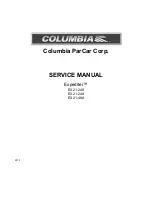
obstructions in the propellers). If the scooter does not start, try disconnecting and then re-
connecting the battery pack.
There is a warning beep which sounds every 60 seconds, this alerts you to the fact that the
controller is powered up. It is also a good reminder to disconnect the controller whilst the
scooter is in storage, or else the controller will completely drain the battery pack if left
connected for a long period (depending on the state of charge, as little as 1 week).
NEVER LEAVE THE BATTERY PACK CONNECTED TO THE MOTOR SECTION
for
extended periods. Doing so slowly discharges the battery and can permanently damage the
battery pack. There is a warning beep which emanates from the controller every 60 seconds
whenever the controller is connected to the battery.
Once the battery pack is charged, and plugged into the motor, install the hull and nose cone.
Be sure the nose cone is not obstructed by any objects on top of the battery pack, such as
trim weights. Obstructions can cause the scooter to flood as it can prevent the nose cone
from sealing correctly.
Entering the water:
Be sure that all main hull clips are secured. (It's a good idea to re-check this on the last deco
stop, as the scooter will only leak at the surface if a latch is unsecured. At depth, the pressure
keeps the scooter sealed.)
For the 1
st
dive, before placing the scooter in the water, set the variable pitch adjustment knob
(in the center of the propellers, at the very rear of the scooter) to a low setting. #5 is a good
start. Also, lock off the thumb screw which is on the left hand side of the trigger/handle. This
will prevent unintended scooter starts whilst lifting the scooter.
Do not place the scooter half in and half out of the water. Place the scooter completely in the
water, and observe the scooter for at least 60 seconds, looking for any leaks. If the scooter is
floating, but starts sinking after a time, and/or any bubbles emerge from the O-ring areas, the
scooter is leaking.
Starting off:
The Magnus has 2 methods of speed control, electronic and mechanical which together allow
almost any speed to be achieved between the minimum and maximum speed.
The mechanical speed control is achieved by adjusting the pitch/angle of the propellers, using
the pitch adjustment knob at the end of the propeller/hub assembly. There are small white
position indicators on the end of the propeller assembly. The mechanical control can only be
adjusted while the scooter is “off”. It can be adjusted during the dive at any time the scooter is
turned off. We recommend setting the pitch to between #6 and #9 (Maximum speed will be
achieved by setting pitch to #9).
The electronic speed control is actuated via the trigger on the handle of the scooter. There are
3 electronically controlled speeds. When you first turn on the trigger, the scooter starts off on












